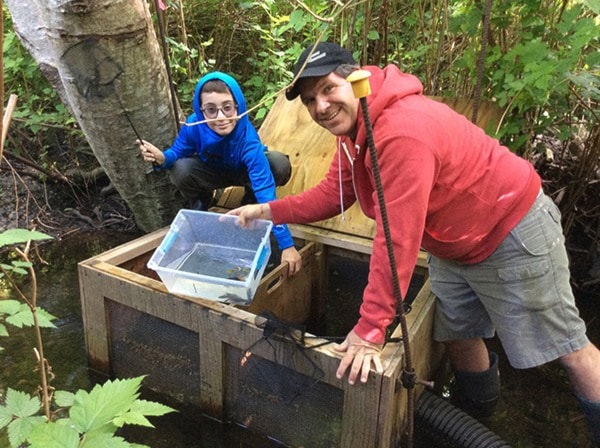The Brooklyn Creek Watershed Society (BCWS) has wrapped up its 2016 Coho smolt count with the help of many local volunteers.
BCWS places a fence to capture all of the Coho salmon (about 9-15 cm long), that have spent slightly over a year in the creek that are going to the ocean. This fence is connected by a large pipe to a counting box where volunteers count the fish every day and then release them on their journey.
Over the last years BCWS also has initiated a number of creek enhancement projects along with the help of the Town of Comox, Pacific Salmon Foundation and several other grantors and the labour of local volunteers. The following table reflects an encouraging trend as to how the society’s projects are helping Brooklyn Creek return to its natural state:
2010 – 3680
2011 – 1504
2012 – 407
2013 – 173
2014 – 3457
2015 – 3137
2016 – 3346
•••
The bad news is the discovery of 100 dead smolts in the counting box this year. This has not happened in previous years.
“The only thing that we might consider a contributing factor is the possibility of toxic substances being washed into the creek,” said BCWS president Robert Deane, in a press release.
“This month of May has been drier than normal, as a result the effluents washed into the creek are not diluted. Many households in Comox are not aware that in the subdivisions built before 1980 and older, all external drains and storm sewers run directly into Brooklyn Creek or other creeks. The majority of the dead smolts occurred after rain has washed the contents of the storm drains into the creek. Low water stresses the fish and makes their trip down the creek more difficult; it only takes a small influx of unusual substances to kill them.”
Deane offered a few suggestions to help alleviate possible toxins entering the creek flow.
“Simple things such as the soapy water from washing your car is best being emptied onto your lawn where the phosphates are absorbed,” he said. “Never wash any concrete or cement products into the drains, they are extremely toxic to fish. We believe most of the incidents are unintentional, since most people are not aware that the storm drains do not go into the municipal water waste treatment centre, and most likely directly into Brooklyn Creek.”
For more information about BCWS, go to brooklyncreek.ca
